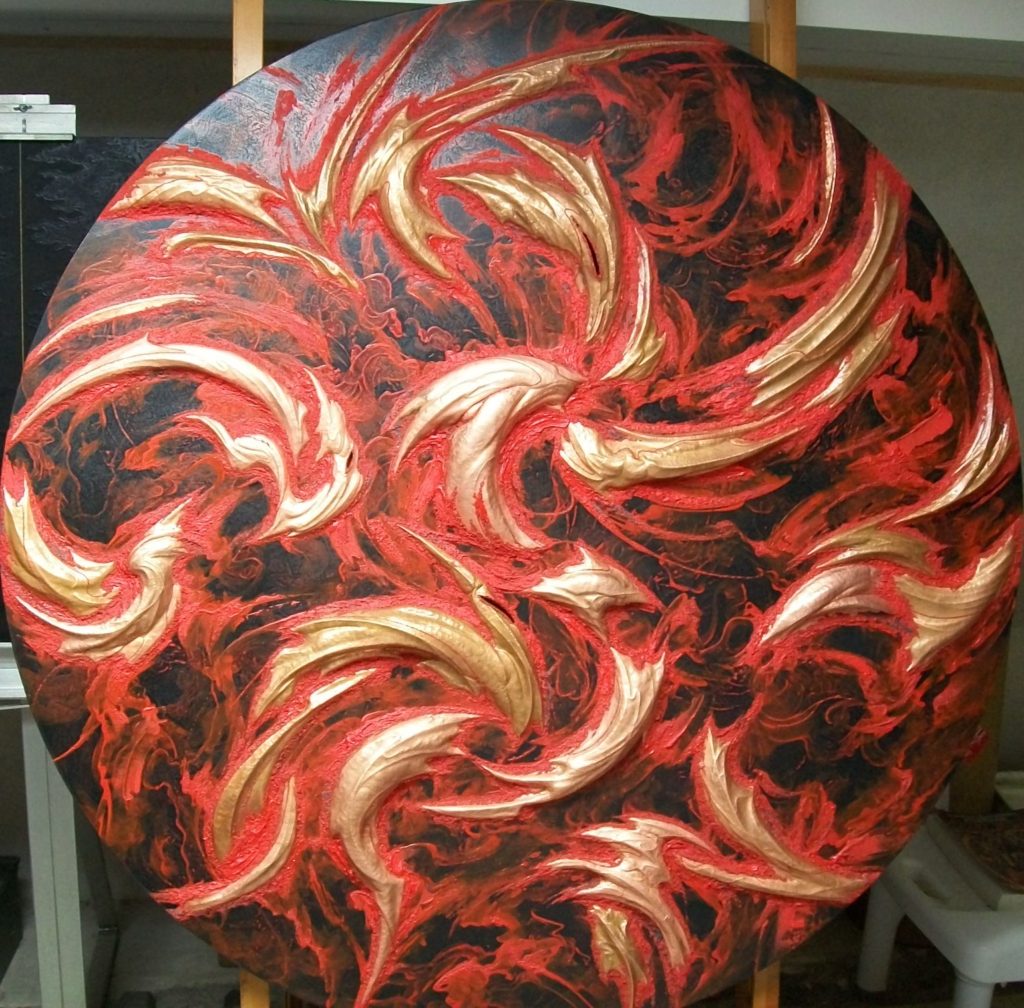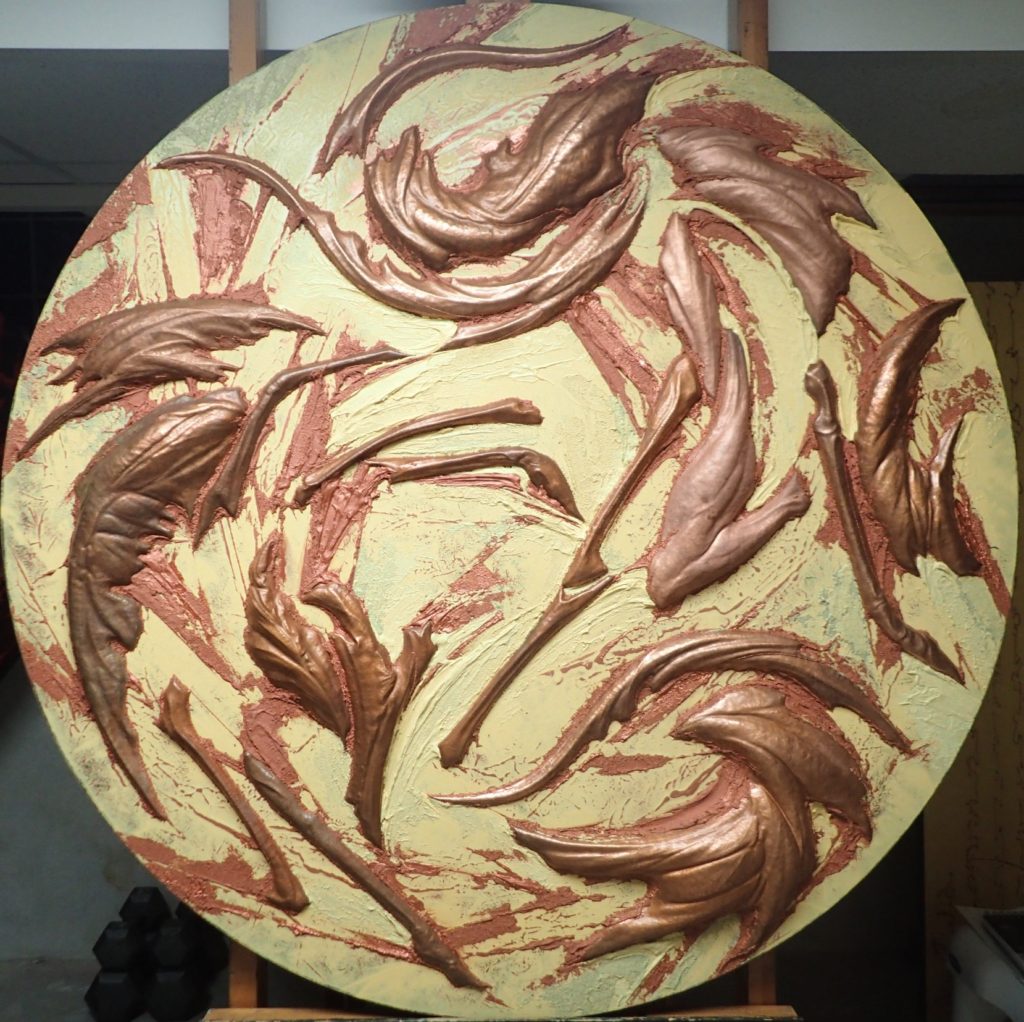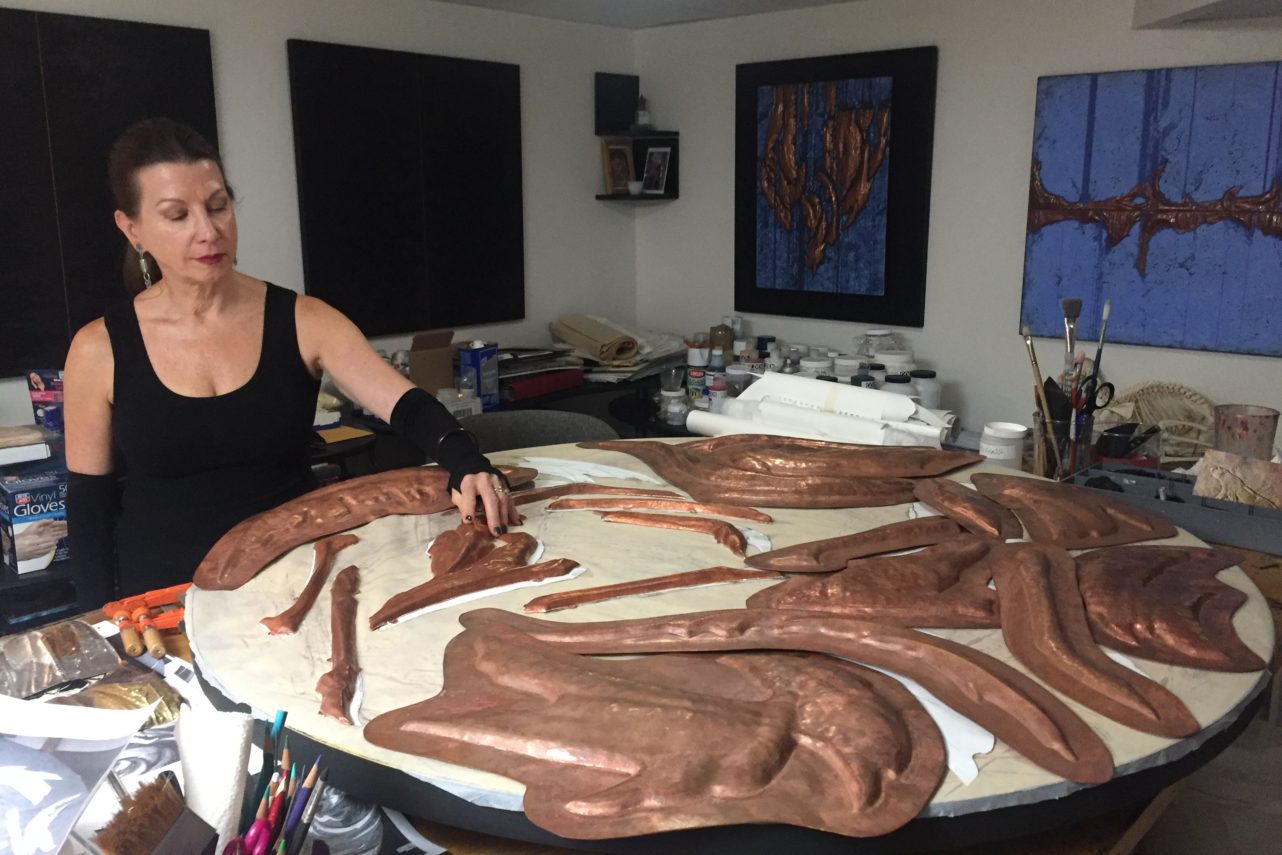Philadelphia artist Maureen Drdak has pioneered a process that no-one else in the world is using, through her work in a Nepali family’s atelier, which dates back almost 500 years—but before her artistic breakthrough, she spent a lot of time in the library.
In high school, she poured over a book about central Asia and China. One photo showed an ancient-style caravanserai (an inn with a courtyard for traveler’s caravans) nestled into a “breathtaking” landscape.
“I was entranced by that photo,” Drdak remembers. Decades later, surfing the web in 2004, she stumbled on it again. Learning that it was a view of the Kali Gandaki gorge in Nepal, she announced to her husband that they were going there.
Drdak graduated from the University of the Arts (then known as the Philadelphia College of Art) in 1975 with a BFA in painting, and earned a certificate in painting from the Pennsylvania Academy of the Fine Arts (PAFA). She soon got married, “and then basically had to earn a living.”
She never stopped her fine art work, but for many years, it took a backseat to a prolific commercial design career. About 20 years ago, she transitioned more into her own fine art work, and doesn’t regret the delay.
“Retrospectively, that was a good thing, because it gave me a lot of time to focus on the conceptual aspects of the work,” she says—and that paid off in a stunning art form melding ancient and contemporary techniques.
“I doubt that I ever would have come upon that concept had I not gone over on my first trip to the Himalayas,” she says now of the path started by a single photo.

Today, Drdak’s work combines delicate copper forms with highly textured acrylic paint on archival wooden substrate panels. The large, circular pieces in her most recent series resemble storm or fire-tossed planets, copper elements surging from the colors like swirling metal archipelagos, or maybe mythic serpents.
Drdak can trace her earliest notions of combining copper with painting to her first visit to the Kathmandu Valley, where an art form called copper repoussé fills the region’s historic architecture. She loved the look of fireguilded repoussé.
Fireguilding is an ancient technique that coats decorative metal with a thick amalgam of gold and mercury, and then uses heat to burn the mercury away, leaving the metal with a gold covering. Over the centuries, the gold wears thin.
“When I saw these eroded pieces of copper with the tissue of gold, thinly veiled on surfaces … I was struck with the painterliness of it all,” the artist remembers. It made her think of paint combined with copper forms. “Initially I discounted it, because it was a very unlikely combination of materials, but I couldn’t get it out of my head.”
Something important clicked when she came across a product called Incralac—a kind of clear, durable lacquer used to insulate outdoor sculptures. Drdak realized she could use Incralac to bind paint to the surface of repoussé copper. In 2009, she returned to Nepal, digging into her savings to test her concept.

She studied at Nepal’s Image Atelier with repoussé master Rabindra Shakya, himself the grandson of internationally known master Kuber Singh Shakya. She calls Rabindra Shakya and his two brothers “the finest family of living [repoussé] masters in the world today.” The family recently completed a copper “colossus” that is larger than the Statue of Liberty—and houses a monastery.
In 2011, thanks to a Fulbright Senior Scholar Fellowship for visual arts, Drdak returned to the atelier for The Prakriti Project, where she further developed her concept. Her project’s title comes from the Sanskrit word prakriti, which “symbolizes both physical matter and the primal creative force that shapes it.”
What exactly is repoussé? As Drdak puts it, it’s “the art of creating a three-dimensional form from sheet metal.” Picture, for example, relief sculptures or massive, ornate Buddha statues, with steel skeletons inside and a glowing skin of repoussé copper. These were “epic creations that would last for centuries.”
“Only a few people in the West practice it,” Drdak says, and even then, it’s usually on a small scale (like jewelry). She’s the only woman to have learned repoussé directly from the Shakya masters.
“I shed a few tears the first time,” she admits. “How hard can it be?” she thought upon arriving in 2009. “Within 60 seconds, I was like, I’m in deep trouble.”
Repoussé artists begin with a design drawn on a piece of copper sheet metal. The sheet is placed on an anvil—not like the Western blacksmith’s anvil, but a long, thick copper rod that tapers at the end. It’s attached to a simple A-frame that points the rod toward the seated artist.
This anvil is called the khalu, and it has various interchangeable heads, called twa. Together, they’re a twakhalu. The artist works the sheet metal from both sides, placing its underside on the twakhalu and then hammering the top side with a specialized, double-headed hammer called a muga. Repoussé artists collaborate closely with expert blacksmiths, who create twa and muga pieces unique to the individuals, allowing them to create flawless one-of-a-kind shapes and textures.
As the artist works, “the copper will, as he’s listening to it, start to sing to him,” Drdak explains. “Its voice will become more and more whiny and high-pitched,” which means it’s getting brittle. The piece goes into the fire to be annealed (strengthened through heating and cooling). It comes out black with firescale, and the hot metal gets a bath of diluted sulfuric or hydrochloric acid, stripping the firescale away. The copper comes out “baby-ass pink,” as Drdak puts it, and then rapidly tarnishes as it oxidizes in the air.
The artist follows these steps repeatedly for each piece of repoussé.
And for Drdak, this is just one part of her work. She begins with her concept design and the first layer of her painting. Once the repoussé elements are finished, they’re cut from their sheet metal matrix, treated with Incralac, and fastened in place on the painted substrate. Then the final stage of painting commences. A single piece in this style takes Drdak about three and a half months to complete.
She’s not teaching her method to anyone else—not yet, anyway. “Because I am so possessed of my vision and my need to achieve that vision, and because the nature of this process is so labor-intensive,” Drdak focuses on her own work, returning to Nepal every year from her studio in Ardmore.
Drdak credits her education in Philly with helping pave the way for her artistic innovation. She says PAFA is well-grounded in the American tradition of painting and its predecessors, but it’s also forward-looking.
“Its method of teaching and learning is very artist-intensive … There’s a particular fluidity within the teaching process of the Academy,” she says of her experience there. The educational focus was more on process than product, which fosters individuality and evolution of vision.
Drdak’s practice is not religious per se, but she embraces an intense, holistic focus that she calls a “spiritual feeling,” connecting her to each element of the work and her intention in creating it.
Just as in Western art, visual arts in Nepal and Asia at large were historically “at the service of religion,” and especially as these traditional forms evolve today, they’re also “extremely rich in terms of mythological and symbolic content.”
For example, a Nepali deity known as Naga can take the form of a snake, representing the health and wellbeing of the environment—specifically the water, Drdak explains. “If the water becomes polluted, these protectors of the environment will leave the environment and take with them their blessings.”
It’s a major theme for Nepali artists today, as global warming threatens the Himalayas. The damages of human development and loss of mountain snowfall jeopardize rivers that sustain billions of people in Asia.
“When the glaciers start to melt, when the rains become erratic, that is not just going to result in a less postcard-friendly image. It’s going to mean tremendous and potentially catastrophic impact” for a huge proportion of the world’s people, Drdak says.

That’s why her current large-scale circular works, slated to be a series of seven (she’s currently working on the fourth) are titled Ardens Mundi, Latin for “burning worlds.” Ultimately, she envisions an exhibition arraying them like a fiery, flooded planetary system.
This meaning in her artwork, infusing everything from her materials to the final brushstroke, is important to Drdak.
“The relationship and engagement with meaning is what makes us human,” she says. “However imperfectly we engage with that thought process, that engagement forms the essence of how we define ourselves.”

